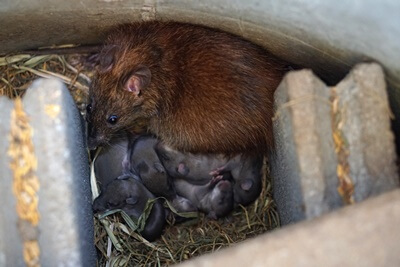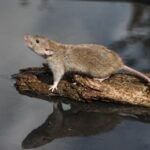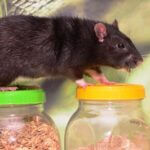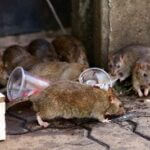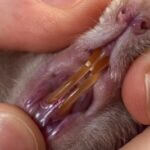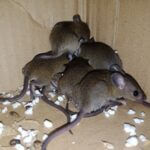On average, a female rat produces 6 litters per year, consisting of 5-10 pups. So, one female rat can produce 30-60 pups annually.
Rats can increase their numbers rapidly due to their short gestation period of 21-24 days. Rats don’t reproduce as quickly as mice, but they multiply quickly.
Female rats can mate immediately after giving birth, meaning that they can produce a new litter every 3 weeks. Rats mature sexually quickly and can breed just 6 weeks after being born.
Once the female experiences her first estrus cycle, she’ll come on heat throughout the year unless she’s already pregnant.
In some cases, female rats will even come on heat once or twice in the early days of pregnancy, making it possible for re-fertilization to take place.
Do Rats Multiply Quickly?
Rats can increase in number at a rapid rate due to the following factors:
Short Gestation Period
Rats are a mammalian species with one of the shortest gestation periods. In rats, the gestation period usually lasts 22 days but can take up to 26 days.
The abdomen of a female rat starts to expand about 14 days into the pregnancy. You might see the pups moving inside her abdomen if you were close enough.
The mammary glands of a pregnant female will start to enlarge in preparation for postpartum nurturing.
Female rats come back into heat (postpartum estrus) within 24 hours of birthing a litter. At this point, they can get pregnant again. This means that a sexually mature female rat can go into heat dozens of times during her lifetime.
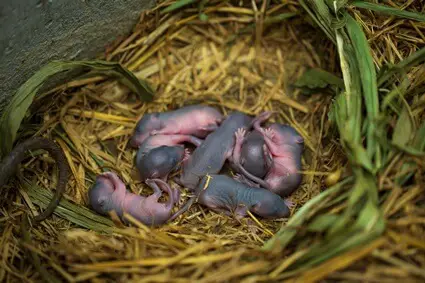
Quick Sexual Maturity
The impressive reproduction rate in rats can also be attributed to their early sexual maturity.
According to the International Journal of Preventative Medicine, rats become sexually mature at about 6 weeks of age. Some female rats have even been known to mature as early as 5 weeks of age.
Once a female rat experiences her first estrus cycle, she’ll go into heat throughout her lifetime. The only exception is when she’s already pregnant.
A female can come into heat during the first few days of pregnancy.
Male rats can sniff out females in heat and will attempt to mount them. Even if a sexually viable female isn’t on heat, a determined male may attempt to stimulate her by sniffing and licking her.
Large Litter Sizes
Rats rarely give birth to single pups. On most occasions, they birth litters of up to 5-10 pups in a go.
On average, females produce 6 litters per year, although this figure varies. This means a single female rat can give birth to 30+ pups per year.
As mentioned, females will come into heat within 24 hours after giving birth. It’s not uncommon for female rats to get pregnant again while still weaning a new litter.
However, this puts stress on the mother, prompting her to kill some of her babies.
How Quickly Do Rats Breed?
Rats reproduce quickly compared to other mammals.
Female rats become sexually viable as early as 6 weeks after birth and remain fertile for up to 18 months. Each adult female can produce more than 30 pups in a single year.
She can then conceive within 24 hours after giving birth.
Do Rats or Mice Breed Faster?
Mice reproduce faster than rats.
According to Purdue University, mice attain sexual maturity as early as 4 weeks of age. They’ll continue to mate throughout the year.
The gestation period in mice averages 19-21 days. Mature females can get pregnant again within 24 hours after giving birth. This means a female mouse can give birth to a new litter every month.
On average, a single litter of mice can consist of 8-14 pups. However, younger mice (4 weeks old) produce smaller litters than mature mice.
How Many Times Do Rats Breed a Year?
Rats are non-seasonal breeders, meaning that female rats come into heat throughout the year.
Unless pregnant, a female rat will experience an estrus cycle every 4-5 days, although it’s also possible for them to come into heat once or twice during the early days of pregnancy.
How Many Babies Do Rats Have at One Time?
A female rat will give birth to between 5 and 10 pups, but the number can be as high as 12. The birthing process takes between 1-2 hours, during which the mother will give birth to one pup every 5 to 10 minutes.
Rats have highly developed maternal instincts and are good at nurturing their young. However, stress from environmental factors can prompt new mothers to kill and eat some of their litter.
How Many Times Can a Female Rat Mate?
Female rats are polyestrous, which means they can breed throughout the year. Once a female reaches the age of sexual maturity (at about 6 weeks), she’s receptive to impregnation about 15 times per year.
This will last for 6 hours each time. During this period, the female can mate multiple times with different males. As stated, it’s not uncommon for female rats to come into heat and mate while gestating.
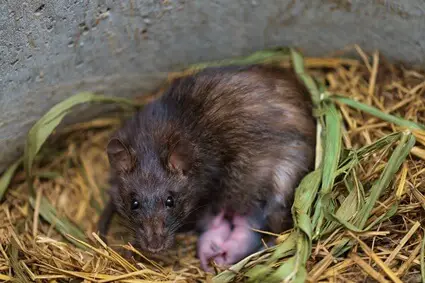
What Factors Affect the Rate of Breeding in Rats?
Many factors can affect the rate of breeding, such as:
Food
The availability of food influences the frequency of breeding in rats.
For instance, in environments with plenty of food, rats tend to be healthy. So, rats are likely to breed more and take care of their offspring.
Malnutrition limits breeding in rats and increase mortality rates in new litters. Pups are more likely to be killed and eaten by their mothers and other rats.
Light Cycles
The reproductive cycle of female rats is sensitive to fluctuations in external lighting conditions. This is because external lights synchronize the timing of ovulation and other events in the estrus cycle.
Any changes in alternating light and dark can cause profound changes in the female reproductive cycle.
Some of the disturbances that are likely to occur include shorter or longer estrus cycles. In some cases, changes in external lighting may halt the estrus cycle in female rats.
Temperature
Rats require a warm environment to live in to raise their offspring. Drops in temperatures during the cold season may reduce the frequency of breeding in rats.
After all, the environment is not conducive to raising pups. On the contrary, when rats find a suitably warm shelter with comfortable nesting material, their mating frequency increases.
Ovarian Cysts
Female rats often develop cysts in their ovaries, disrupting their estrus cycle. Older rats are more susceptible to ovarian cysts, leading to the early onset of menopause and infertility.
According to Reproductive Biological Endocrinology, reproductive aging is marked by a shift from the normal 4-5-day estrus cycle to cycles of varying lengths.

